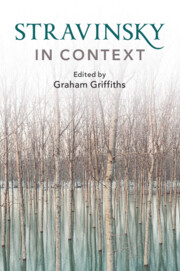Book contents
- Stravinsky in Context
- Composers in Context
- Stravinsky in Context
- Copyright page
- Contents
- Illustrations
- Contributors
- Preface
- Abbreviations
- Frontispiece
- Epigraph
- Part I Russia and Identity
- Part II Stravinsky and Europe
- Part III Partnerships and Authorship
- Chapter 12 Stravinsky’s Sphere of Influence: Paris and Beyond
- Chapter 13 Stravinsky and His Literary Collaborators
- Chapter 14 Assuming Co-authorship: Stravinsky and His ‘Ghostwriters’
- Chapter 15 Nadia Boulanger and Stravinsky: The Transition to America
- Chapter 16 Conversations with Craft
- Part IV Performance and Performers
- Part V Aesthetics and Politics
- Part VI Reception and Legacy
- Recommendations for Further Reading and Research
- Index
- Endmatter
Chapter 15 - Nadia Boulanger and Stravinsky: The Transition to America
from Part III - Partnerships and Authorship
Published online by Cambridge University Press: 03 December 2020
- Stravinsky in Context
- Composers in Context
- Stravinsky in Context
- Copyright page
- Contents
- Illustrations
- Contributors
- Preface
- Abbreviations
- Frontispiece
- Epigraph
- Part I Russia and Identity
- Part II Stravinsky and Europe
- Part III Partnerships and Authorship
- Chapter 12 Stravinsky’s Sphere of Influence: Paris and Beyond
- Chapter 13 Stravinsky and His Literary Collaborators
- Chapter 14 Assuming Co-authorship: Stravinsky and His ‘Ghostwriters’
- Chapter 15 Nadia Boulanger and Stravinsky: The Transition to America
- Chapter 16 Conversations with Craft
- Part IV Performance and Performers
- Part V Aesthetics and Politics
- Part VI Reception and Legacy
- Recommendations for Further Reading and Research
- Index
- Endmatter
Summary
Igor Stravinsky departed France for the United States aboard the SS Normandie on 23 November 1939. He was destined for Harvard, having agreed to deliver that year’s Charles Eliot Norton Lectures beginning on 18 December. From the outset the trip was meant to be temporary, a welcome opportunity to profit from Harvard’s lucrative position and explore further American opportunities. But while there, political tensions in Europe escalated and what many had hoped would be a short-lived war grew into a global-scale conflict. Stravinsky recognised the advantages of remaining where he was. Within the year he had filed for and received American citizenship and this new country became his adopted home until his death on 6 April 1971. During his first months in the United States Stravinsky benefitted from a network of musicians and socialites sympathetic to his music, a community assembled in large part through the advocacy of American-based colleagues and friends such as the violinist Samuel Dushkin, actor Dagmar Godowsky and, particularly, the celebrated French composer, conductor and teacher Nadia Boulanger (Fig. 15.1). Her circle of contacts played an especially vital role in facilitating Stravinsky’s activities during his early months in America.
- Type
- Chapter
- Information
- Stravinsky in Context , pp. 133 - 142Publisher: Cambridge University PressPrint publication year: 2020



